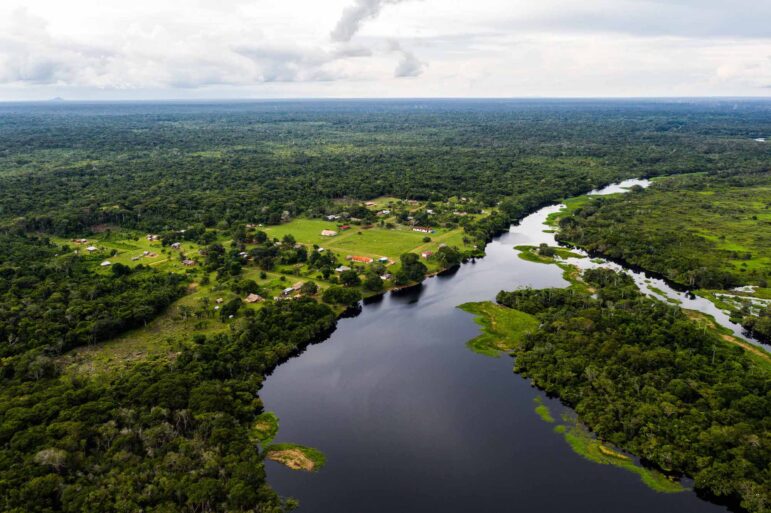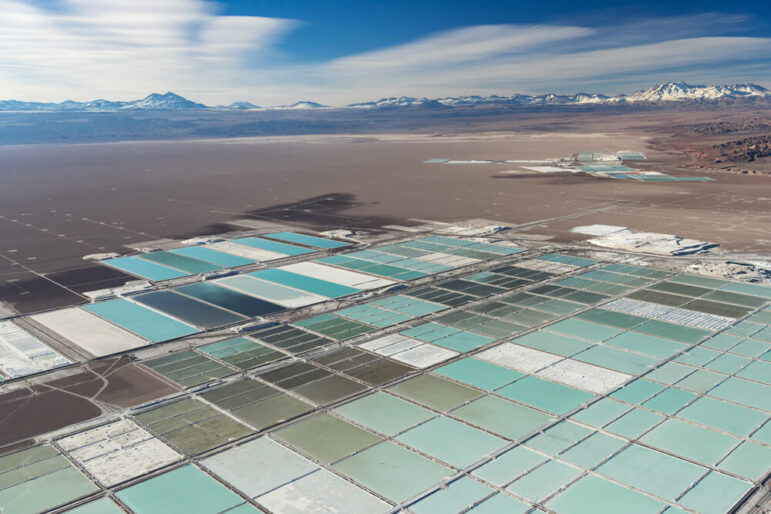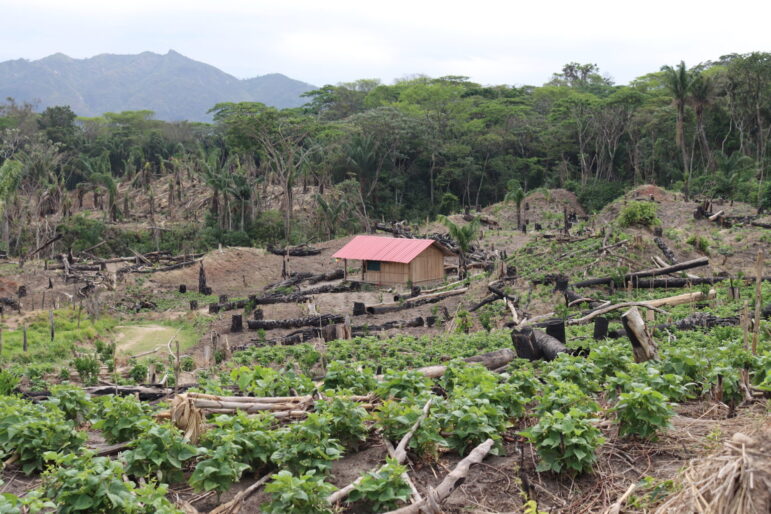Throughout 2023, a focus of Mongabay’s Spanish-language news bureau, Mongabay Latam, was the unrelenting pressures on protected areas in Bolivia and Chile. Mongabay Latam’s steadfast coverage throughout the year is reflective of the team’s commitment to objective and factual environmental reporting. This overview highlights critical socio-environmental challenges facing protected areas in these regions and the real-world impacts that have emerged due to Mongabay’s efforts to increase awareness and transparency through independent journalism.
A critical look at threats to protected areas in Bolivia

The Bajo Paraguá Municipal Protected Area in Chiquitanía, Bolivia is an area exposed to encroachment. Photo by the Foundation for the Conservation of the Chiquitano Forest.
In Bolivia, the long-term toll of these pressures was made clear when a Mapbiomas report revealed a loss of 7.9 million hectares of forest over the past 37 years. This deforestation mainly affects three protected areas: Amboró National Park, Bañados de Izozog (one of the country’s most extensive wetlands in the Chaco), and Guarayos Forest Reserve. This history underscores the additional loss of 385,000 hectares of primary forest in 2022, the highest figure in recent years, according to a Global Forest Watch report.
Deforestation caused by expanding the agricultural frontier to introduce more soy and cattle pasture triggered a new wave of fires in Bolivia. By October, flames engulfed two million hectares nationwide, including the Noel Kempff Mercado National Park and the Pilón Lajas Community Land and Biosphere Reserve. Not only have protected areas been affected by the fires, but land invasions have continued and legal claims by Indigenous peoples, such as the Tsimane communities, have increased. Another growing issue in Bolivia is the dispute over gold mining in rivers,. Increasingly, gold mining cooperatives are demanding that the state rescind the measure that prevents the granting of new permits for gold mining in protected areas.
Revealing threats to protected areas in Chile

Lithium mine in Atacama. Photo by Guy Wenborne.
In Chile, conflicts focus on lithium mining, aquaculture and new road infrastructure. The publication of the National Lithium Strategy, presented by President Gabriel Boric at the end of April, sparked debate among experts and communities in the country. The environmental record of Codelco, the lack of resources for monitoring and the fact that communities still need to be consulted keep the Indigenous population on alert. The situation worsened because some of the most important reserves are within protected areas, such as the Salar de Tara, part of the Los Flamencos National Reserve.
Additionally, the Chilean government proposed a controversial road project that would link the towns of La Unión and Corral, but cut through the Alerce Costero National Park.
In terms of Chile’s marine ecosystem, the salmon industry protested against the new requirements for granting concessions within marine protected areas.
Strengthening protected areas
Despite these challenges, conservation efforts continue and at times, succeed. Chile finally created the Desierto Florido National Park and the Biodiversity and Protected Areas Service, which are dedicated exclusively to caring for protected areas. Chile also witnessed the return of the Antillean penguin to Chañaral Island in the Humboldt Penguin National Reserve.
In Bolivia, another protected area was created: the Quebracho and Condor Natural Reserve in the Cordillera de Laderas.
Special coverage

Trees were felled to plant crops at the entrance to Amboró National Park in Bolivia, in the Nuevo Surutú community. Photo by Iván Paredes.
Among Mongabay Latam’s regular reporting, the following three in-depth reports emerged that spurred notable impact:
The climate crisis in the Cape Horn Biosphere Reserve
This series calls attention to a group of scientists trying to understand the changes the climate crisis is causing in the southernmost temperate forests of the planet. There, the increase in temperature and the decrease in rainfall have modified the life cycles of some insects; wetlands have dried up; ice floes have disappeared; and the populations of different animals have drastically decreased. Invasive and exotic species also threaten native populations. Biotechnologist and expert Brenda Riquelme shared her thoughts with Mongabay, emphasizing the need for active monitoring and climate action.
The Debt of Oil
For eight months, a team of local journalists investigated the severe environmental impacts of the oil industry in Peru, Colombia, Bolivia and Ecuador. Mongabay Latam identified more than 8,000 oil-contaminated sites, ranging from broken pipelines and abandoned junkyards to oil pools, pits and water sources. At least 670 oil spill sites are in protected natural areas and Indigenous territories. Additionally, there are 94 abandoned oil wells in Bolivia, most of which are located within the Aguaragüe Park.
Land invasion series
In partnership with El Deber de Bolivia, Mongabay Latam’s investigative series highlights three cases of illegal settlements growing out of control on public, private, and protected lands. The forests of the San Rafael Reserve, the Amboró National Park, and the El Curichi-Las Garzas protected area are examples of this severe problem. Mongabay reporters traveled to each of these locations to report first-hand on the extent of deforestation, drug trafficking and the logging of valuable wood species.
Impact

Glaciers have retreated by 56% in Bolivia between 1985 and 2022. Photo by FAN Bolivia.
Reaching other media outlets
Mongabay’s coverage on protected areas in Chile and Bolivia generated a range of real-world impacts.
Beyond Mongabay’s channels, our original reporting has been republished more than 70 times thus far by media and environmental organizations from seven countries throughout Latin America. Also, Mexico’s public radio station IMER also interviewed Mongabay Latam’s editor to explain the findings of the investigation The Debt of Oil.
This broader dissemination has helped elevate environmental issues in the public discourse, contributing to a greater awareness of the challenges and solutions related to conservation.
Exposing unauthorized mineral extraction
Other impacts take more time to develop. In February 2021, Mongabay published an investigation into Quiborax, a company that extracts a mineral for producing boric acid, borax, and other agrochemicals. According to our research, the company’s activities have not been environmentally assessed and could impact one of Chile’s most fragile ecosystems.
Following publication, an official from the National Forestry Corporation, Conaf, told the reporter that they decided to inspect the company on-site due to the information revealed. Conaf discovered during the visit that the company was operating in unauthorized areas. Quiborax agreed to remedy the situation within a certain period. The deadline passed without the company complying with the agreement, so Conaf filed a complaint against Quiborax with the Environmental Superintendency.
Award-winning coverage
Demonstrative of the quality of reporting, Karen Gil’s journalistic work on the advance of deforestation caused by coca cultivation in the Indigenous Territory and Isiboro Sécure National Park in Bolivia won the Franz Tamayo Award in the Investigative Magazine category. Similarly, the Climate Crisis at Cape Horn series won the IAPA’s Excellence in Journalism 2023 Award in the Chronicle category. The jury lauded the reporter’s work in covering a scientific effort to track and mitigate the effects of climate change on the flora and fauna of the planet’s southernmost forest.
Engagement with decision makers on lithium mining
A notable example of Mongabay’s influence on policy-making is the response to a report about the interest in expanding the scope of lithium mining in Chile to the Maricunga Salt Flat, the second-largest lithium reserve in the country. Reporter Barinia Montoya gathered testimonies of experts and communities living in the area, who pointed out that mining would threaten to transform the desert landscapes, biodiversity, and the ancestral territory of the Colla Indigenous people.
Following the publication, a delegation of British members of parliament invited Montoya to present the publication’s findings while they were visiting Chile to report on the development of the critical minerals industry, particularly lithium.
Support independent environmental journalism
Mongabay aims to continue to increase awareness and understanding of the threats and solutions underway for protected areas in Chile and Bolivia. If you are interested in helping sustain impactful, independent news like this, there are two excellent ways you can do so with Mongabay. First, consider making a donation, which directly helps us continue to produce high-impact journalism from Nature’s frontline. Second, subscribe to Mongabay’s newsletter to get the latest environmental news delivered right to your inbox.
About Mongabay
Mongabay is a nonprofit environmental science and conservation news platform focused on providing cutting-edge independent journalism from Nature’s frontline. We pride ourselves on producing reporting that has substantial, tangible impacts around the world.